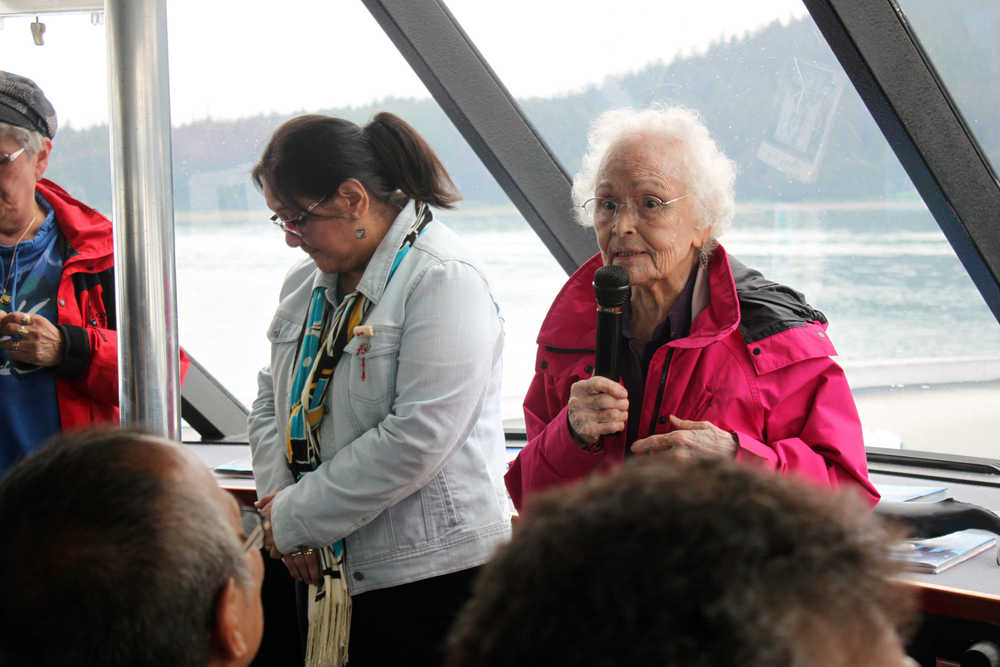For John Morris, the Douglas Indian Association’s day cruise to the Taku Inlet on Friday meant laying his younger brother, Jake Morris, to rest.
“I laid a dozen roses on the river and then I did his ashes. I told him, ‘I carried out your wishes. I did exactly what you wanted me to do,’” Morris, 76, said during an interview on the boat.
Morris is a tribal council member of the DIA, which hosted the boat trip. Jake Morris lived in Anchorage and passed away in the spring. He was a veteran, having served two tours in Vietnam.
Growing up, Morris and his two brothers spent their winters in the Douglas Indian Village and attended school. From May to October, they were on the Taku River.
“Both my bothers and I grew up on that river — gillnetting, setnetting, fishing, picking berries, moose hunting. We did everything together there,” Morris said.
Friday wasn’t the first time Morris has spread ashes on the Taku. He did the same for his other younger bother, James, his wife, Linda, and it’s where he wants his own ashes to be laid to rest.
Morris recalled once being on the Taku with federal workers who asked him to point out sacred spots on the river. He told them, “This whole place is sacred.”
Morris’ relationship with the river exemplifies the close ties the T’aaku Kwáan and the A’akw Kwáan had to the Taku and other waterways surrounding Juneau, Douglas and Auke Bay. Highlighting these historical ties and present connections was the main goal of the boat cruise, said DIA tribal administrator Andrea Cadiente-Laiti.
“We’re a tides people. Waterways are what connected us to village sites. Our means of travel was trail and boat. When we talk about our traditional territories, the very waterways that you’re seeing are part of that,” she said.
[Tribal group seeks payback for burned, stolen land]
Starting in Statter Harbor in Auke Bay, an Allen Marine catamaran carrying about 100 invited guests and DIA staff traveled to different former Native village sites around Juneau throughout the day.
Cadiente-Laiti said the trip brings together tribal members, other tribal organizations and representatives from local, state and federal agencies, like the City and Borough of Juneau, Juneau School District, the lieutenant governor’s office, U.S. Forest Service and Bureau of Indian Affairs.
As a federally recognized tribe, she said the goal is to share the history of the T’aaku Kwáan and the A’akw Kwáan, including the 1956 paving of the Douglas Indian Cemetery to build Douglas Highway and Gastineau Elementary School, and the 1962 burning of Douglas Indian Village by the Douglas City Council.
“We feel that unless we address the historical trauma and multigenerational grief, we’re not going to be here to protect the lands and waters, and be good stewards. With that comes a huge need for community and government awareness of who Douglas Indian Association is,” Cadiente-Laiti said.
[Healing history and undoing the silence: Totem poles to acknowledge atrocities in Douglas]
The trip started with the A’akw Kwáan territory. The boat lingered in front of an area near Indian Point and Auke Rec.
Marie Olson, a respected elder of the A’akw Kwáan, welcomed everyone to her homeland, which she said extends from Young Bay past Berners Bay.
“Indian Point is an important place for the A’akw Kwáan. As far as the A’akw Kwáan are concerned, it’ll remain that way forever,” she said speaking into a microphone.
Despite what happens at the local, state or federal level, “it is our sacred place,” Olson said. “We’ll always be trying to make everyone understand that this is Tlingit Aani. No one can change that.”
Fran Houston is also of the A’akw Kwáan.
“When I walk through Auke Rec area, I visualize my ancestors being on this land,” she said. “From the stories I heard from my grandmother and my mother, we had a village over in this area and our people would come here. They would fish, they would stock up on berries. They did everything they could to prepare the food that was needed for the family to hold them through the winter months.”
The boat continued around the backside of Douglas, past Marmion Island, to Gastineau Channel to check out Mayflower Island and Sandy Beach, and then back down the channel into Taku Inlet.
Tlingit elder Margaret Dutson said her father was of the Yanyeidí tribe.
“I want people to recognize my father’s people who at one time owned this whole river. They always used to tell me as a little girl, ‘Your beautiful father’s river will flow forever,’” Dutson said.
She said her father fished in the area and her family spent a lot of time on the river.
“I lived in some of those cliffs. I ran around as a little 4-year-old girl, I still remember we had a cabin that we loved and we were always together,” Dutson said. “I want to thank all of you for showing the deep respect to my father’s country.”
[DIA still seeks memorial for school burial ground]
Referencing the book, “Gágiwduł.àt: Brought Forth to Reconfirm The Legacy of a Taku River Tlingit Clan,” DIA tribal council member Barbara Cadiente-Nelson said part of healing is knowing your story and telling it.
She said due to collision of cultures and time passing, so much history has been lost, but place can help fill in the gaps.
“The river itself,” she said, “it will tell you that story.”
“That’s what this [trip] is all about,” Cadiente-Nelson continued. “When you leave this great ship, you will have seen yourself in the story of this area and understand your role in it.”
• Contact reporter Lisa Phu at 523-2246 or lisa.phu@juneauempire.com.
Related stories:
Finding fault with fowl rule, hundreds in Juneau petition for rooster regulation change
State hopes court will dismiss lawsuit affecting fisheries commission reorganization
PokéMob moves through downtown Juneau

